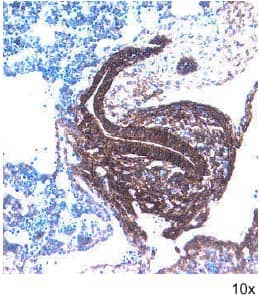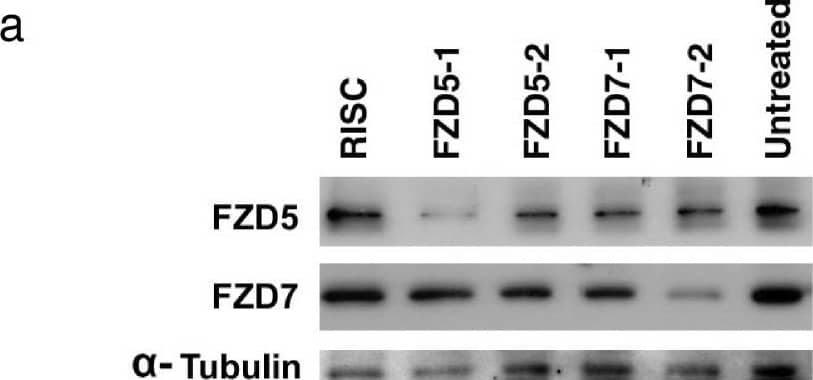Mouse Frizzled-7 Antibody
R&D Systems, part of Bio-Techne | Catalog # AF198


Key Product Details
Species Reactivity
Validated:
Cited:
Applications
Validated:
Cited:
Label
Antibody Source
Product Specifications
Immunogen
Gln33-Leu185
Accession # Q61090
Specificity
Clonality
Host
Isotype
Scientific Data Images for Mouse Frizzled-7 Antibody
Detection of Mouse Frizzled‑7 by Western Blot.
Western blot shows lysates of HepG2 human hepatocellular carcinoma cell line. PVDF membrane was probed with 0.25 µg/mL of Goat Anti-Mouse Frizzled-7 Antigen Affinity-purified Polyclonal Antibody (Catalog # AF198) followed by HRP-conjugated Anti-Goat IgG Secondary Antibody (Catalog # HAF019). A specific band was detected for Frizzled-7 at approximately 65 kDa (as indicated). This experiment was conducted under reducing conditions and using Immunoblot Buffer Group 1.Frizzled‑7 in Embryonic Mouse Gastrointestinal Tract.
Frizzled-7 was detected in immersion fixed frozen sections of embryonic mouse gastrointestinal tract (11 d.p.c.) using 15 µg/mL Goat Anti-Mouse Frizzled-7 Antigen Affinity-purified Polyclonal Antibody (Catalog # AF198) overnight at 4 °C. Tissue was stained with the Anti-Goat HRP-DAB Cell & Tissue Staining Kit (brown; Catalog # CTS008) and counterstained with hematoxylin (blue). View our protocol for Chromogenic IHC Staining of Frozen Tissue Sections.Detection of Frizzled-7 by Western Blot
Knockdown of FZD5 and FZD7 leads to a reduction in growth of EC cells. NT2/D1 and NT2/D1-R1 cells were individually transfected with siRNAs to knockdown FZD5 or FZD7, or with a control siRNA construct, pGL2 or RISC. Graphs depict a representative experiment performed in triplicate. Error bars represent standard deviation. a) Expression of FZD5 and FZD7 proteins in NT2/D1 cells was quantified using immunoblotting on non-reducing gels. b) Number of NT2/D1 cells and c) number of NT2/D1-R1 cells after 4 days compared to initial number of seeded cells. (* p < 0.05, **p < 0.005, ***p < 0.0005). Image collected and cropped by CiteAb from the following open publication (https://pubmed.ncbi.nlm.nih.gov/19874621), licensed under a CC-BY license. Not internally tested by R&D Systems.Applications for Mouse Frizzled-7 Antibody
Immunohistochemistry
Sample: Immersion fixed frozen sections of embryonic mouse gastrointestinal tract (11 d.p.c.)
Western Blot
Sample: HepG2 human hepatocellular carcinoma cell line
Formulation, Preparation, and Storage
Purification
Reconstitution
Formulation
Shipping
Stability & Storage
- 12 months from date of receipt, -20 to -70 °C as supplied.
- 1 month, 2 to 8 °C under sterile conditions after reconstitution.
- 6 months, -20 to -70 °C under sterile conditions after reconstitution.
Background: Frizzled-7
The Wnt genes encode a large family of glycoproteins that are essential in development and tissue maintenance (1). Members of the Frizzled family of proteins serve as receptors for the Wnt signaling pathway (2). The predicted structure of Frizzled proteins is similar among all family members, containing a divergent N-terminal signal peptide, a highly conserved extracellular cysteine-rich domain (CRD), a variable-length linker region, a seven-pass transmembrane region, and a variable-length C-terminal cytoplasmic domain. The CRD, which comprises the Wnt binding site, spans about 130 amino acid residues and contains ten invariant cysteine residues. Mouse Frizzled-7 contains 572 amino acid residues and shares 99% identity with the human orthologue in the CRD (3, 4). Frizzled-7 mRNA has been detected in relatively large amounts in adult skeletal muscle, plancenta and heart, and fetal kidney and lung (3). Several Frizzled-dependent signaling pathways exist (2). Their activation depends on the Wnt ligand and the cell context. Frizzled-7 can activate canonical Wnt/ beta-Catenin signaling, as well as a non-canonical pathway involved in tissue morphogenesis (4, 5).
References
- Wodarz, A. and R. Nusse (1998) Annu. Rev. Cell Dev. Biol. 14:59.
- Hsieh, J-C. (2004) Front. Biosci. 9:1333.
- Sagara, N. et al. (1998) Biochem. Biophys. Res. Commun. 252:117.
- Sheldahl, L.C. et al. (1999) Curr. Biol. 9:695.
- Medina, A. et al. (2000) Mech. Dev. 92:227.
Alternate Names
Gene Symbol
UniProt
Additional Frizzled-7 Products
Product Documents for Mouse Frizzled-7 Antibody
Product Specific Notices for Mouse Frizzled-7 Antibody
For research use only

